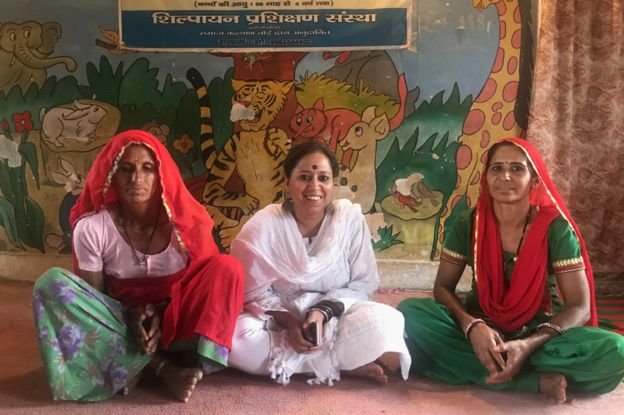A prison where the inmates have to go and find jobs

At Sanganer jail, in the Indian city of Jaipur, prisoners get a rooftop over their head, however no cash and no sustenance. This implies they should go to work and gain their living past the jail doors, composes Masuma Ahuja - as workers, assembly line laborers, drivers, even yoga instructors.
Ramchand drives a school transport. His significant other, Sugna, works at an article of clothing plant. On an ongoing hot evening, I drink some tea with them in their one-room house, which has yellow dividers and a folded metal rooftop, a refrigerator and a TV, a lunchbox hanging in the corner alongside photographs of divine beings and a heap of papers. From their entryway, you can see autos zooming by on a close-by parkway and past that, a horizon of present day tall structures.
This is the way they recount their story: he was forlorn, her family had abandoned her. Their neighbors needed to set them up and orchestrate their marriage, so she wouldn't be a lady living alone, so he would have somebody to deal with him, cook for him and make him rotis. "I can make my very own rotis," he says. He wedded her since he succumbed to her.
There's apparently minimal strange about their home, or their story. Then again, actually Ramchand and Sugna are both sentenced killers and they live in jail.
Their home is in Sanganer Open Prison, in Jaipur, the capital city of India's western territory of Rajasthan. This jail has no bars or dividers, no security watches at the entryway, and detainees are permitted - even empowered - to go out into the city and work each day. This jail, which has been open since the 1950s, is home to 450 detainees and is one of around 30 such organizations in the province of Rajasthan.
I go to Sanganer with Smita Chakraburtty, the lady behind a battle to make open detainment facilities the standard crosswise over India. She has presented the defense to India's Supreme Court, which thus has requested that states investigate setting up more places this way. She presently fills in as a privileged official of detainment facilities in Rajasthan, and as of late won the nation's Agami Prize for her work on the reformatory framework.
"The criminal equity framework tends to an episode… and doesn't comprehend how to manage an individual," Chakraburtty contends. Her motivation is picking up force: four different states in India set up new open detainment facilities a year ago. When I visit Sanganer with Smita, she gives detainees the most recent reports on her work, and after that they swarm to me, anxious to talk. While there are no watchmen and anybody can enter the jail, guests like me are uncommon.
I sit on the floor in a kids' nursery at the front of the jail grounds and chat with a gathering of people who are detainees. When I ask them for what good reason they're in jail, numerous essentially state, "302," alluding to Section 302 in India's Penal Code which manages the discipline for homicide. They call the open jail "the homestead," and spout about the fact that it is so natural to live here, how glad they are.
To get to Sanganer, they all must have served something like 66% of their sentences in shut penitentiaries, and they state that contrasted with those spots, this is opportunity. Actually, the administration in Rajasthan has needed to expel detainees who would not like to leave. They had set up lives - stable occupations, schools for their youngsters - in this area, that they would not like to surrender toward the finish of their sentences.
All things considered, numerous detainees disclose to me they battle with untouchables' impression of jail. A few ladies detainees state it's less demanding to wed a man within, in light of the fact that men outside jail don't comprehend their encounters. Notwithstanding finding a new line of work can be hard for a few detainees, they state individuals are reluctant to enlist them once they present their jail IDs.
Open jails in India
Toward the finish of 2015, out of a sum of 419,623 detainees in India, 3,789 (0.9%) were held in open penitentiaries
Two states, Rajasthan and Maharashtra had 42 open jails - the greater part of the aggregate
Twenty-one open jails were appropriated among 15 different states
Source: Prison Statistics India 2015
Be that as it may, despite everything they live a variant of an ordinary life here: they purchase cruisers, cell phones, and TVs; they wear no jail uniform and live in little numbered houses. Every detainee is designated a legislature gave house along one of Sanganer's thin paths. The rest is up to them. The jail doesn't give them any sustenance, water or pay.
So consistently, the vast majority of them leave the jail grounds to acquire a living: men sentenced for homicide function as security watches, assembly line laborers and day by day workers. I even meet one detainee who's a yoga educator and another who's a boss in a close-by school.
The main genuine standard, I'm told, is that detainees must make move call each night. Sanganer barely appears to be a jail, aside from as of now. At twilight, delegates of the jail's chosen administering body remain at the jail entrance. A detainee with a receiver starts taking participation, getting out numbers from 1 to 450. In some cases, he stops at a number and chides a detainee for going out.
Everybody must be represented… or chance come back to a shut jail.
Japan is in the grasp of an old wrongdoing wave - the extent of violations submitted by individuals beyond 65 20 years old been relentlessly expanding for a long time. The BBC's Ed Butler inquires as to why.
please upvote.....